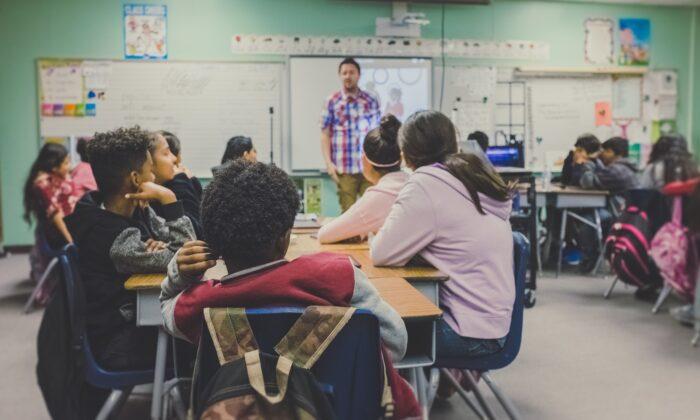When she arrived, Hilda Maldonado’s top priority was to entrench bilingual learning into the county’s curriculum, a program she had spent most of her career advocating for as part of her woke agenda. On March 22, 2021, she introduced the first of many proposed “dual language immersion” programs she would institute, starting in McKinley Elementary School. This program follows a “90:10 model,” in which kindergarteners are instructed 90 percent in Spanish and 10 percent in English; first graders are instructed 80 percent in Spanish and 20 percent in English; second graders are instructed 70 percent in Spanish and 30 percent in English; and so on. The slogan unveiled was: “Go slow to go fast.”
The slogan should have been: “Go slow to go even slower.” In a longitudinal study of the value of bilingual language education to preschoolers, researchers found that kids randomly assigned to a TBE (transitional bilingual education) program, in which they were instructed in Spanish more than 70 percent of the time, produced overall English-language learning results significantly lower than kids randomly assigned to an EO (English only) teacher. Although the sample used in the study is too small to be statistically significant (only thirty two kids), it reflects the experiences of teachers who have taught bilingually in the past, including Karen Lithgow, the northern Virginia teacher whom I interviewed in chapter 2. Lithgow said skeptically that “it depends on the kid” whether bilingual education really helps, adding that while it could help kids who had “just come from Mexico” (mostly children of illegal immigrants) feel more comfortable in the classroom environment, it ends up being unhelpful to kids who want to raise their English skills to the level of their American-born peers.
Hilda and her allies justified her bilingual education program in the language of cultural exchange: “We’re providing a gift to students to connect with cultures that they might have not connected to before,” said the McKinley principal, Elena Garcia-Yoshitomi. But others framed it more specifically in terms of race: Maria Larios-Horton, the director of diversity, equity, and family engagement at Santa Barbara Unified, said, “Let’s say I don’t look like some of our other families; maybe my child has blonde hair and blue eyes.” She continued, “By the end of kindergarten, you’ll be able to see the children talking to one another in Spanish, singing together, talking together. It will bring tears to your eyes.”
The district’s wealthy white liberals cried with joy. I’m sure the picture of diverse kids speaking more than one language played well with the champagne-and-caviar crowd that populates Santa Barbara’s rolling hills. Maldonado advanced, triumphant, a wide grin on her face—the face of the new education program imprinted upon the heavily Hispanic McKinley Elementary School and soon to be exported to schools across the county.
Only one educator seemed publicly skeptical that day, and she was out of power, disgruntled, and forced to air her opinions on the back page of the Santa Barbara News-Press. “How are they going to compete [in English]? They’re going to be so far behind,” an elderly Rosanne Crawford grumbled. The silver-haired lady, a Hispanic mother of two, wore a pompadour and the haughty look of a proud woman. A former educator, she saw only bad things in the new push to make low-income Hispanic children learn via multilingual education. Why? Because she had seen the effects firsthand.
Rosanne recounted in an interview with me the story of a young girl whom she tutored in Santa Barbara, a child of immigrants from Mexico. With help from an elementary school teacher—Rosanne herself—the girl worked hard to get to grade level in English, but when she left for junior high, she lost that English-language support. That’s because her parents checked a box labeled born in Mexico when she was younger—likely thinking it would have no effect on their child’s life. They were wrong. Because of her country-of-origin designation, this girl was automatically sent to a junior high class where she was with “these students that were basically English as a second language students; she was up to grade level, these guys weren’t... She sat there and she didn’t learn anything,” Rosanne said, sighing at the misfortune of the girl she had known and tried to help. “She’s homeschooling now,” Rosanne said, because the Santa Barbara English-learning system failed her. Her immigrant parents had no idea that assignment to “bilingual education,” in which English is taught as little as 10 percent of the time in the classroom, was the consequence of checking a box.
Armed with knowledge and a certainty that bilingual education programs were exacerbating the literacy problems of the low-income Hispanic community in Santa Barbara and preventing kids from moving forward, Rosanne sought to confront the new superintendent, Hilda Maldonado, about the issue. After seeing that Maldonado had been checking her profile on LinkedIn (probably because she’d heard about Rosanne’s opinion on the issue), Rosanne had the stones to reach out over the platform. “Hi, Dr. Maldonado. I saw you checked out my profile on LinkedIn. Are you interesting in talking?” Then Rosanne waited.
A couple of hours passed. Then Hilda Maldonado replied, “Of course I’d like to meet!”
At the superintendent’s office, Rosanne met Hilda. The gregarious Latina strolled out, charming and imposing. She was a disarming character. Her smile could convince you that she had your best interests at heart. Still, Rosanne didn’t let Hilda’s personality fool her. She was a woman on a mission.
“So how can I help you?” Maldonado asked.
“I just want to ask, Hilda,” Rosanne said, clearing her throat, “why you are so high on this bilingual-education stuff when you, a first-generation immigrant yourself, are able to speak fine English and Spanish as the product of a monolingual program?”
“The reason I did so well [at English],” Hilda responded, “is because I had a teacher, and I had after-school help.”
Rosanne stiffened as she began to recognize Hilda’s strategy of evasion, her effort to frame the discussion as a matter of privilege and oppression instead of technique. But she decided to play Hilda’s game.
“Well, that’s interesting, Hilda, because in a lot of the schools now, students are not getting that,” she said. “[These Latino students] are being taught English, but when they go home, they don’t get the support. That’s where it needs to be shored up. You need to support the teachers with people who will help in this regard.”
Later, Rosanne told me, “And she absolutely agreed. So I asked her, ‘Can we at least have one track left at McKinley that’s all English, and then you can institute your META [Multilingual Excellence Transforming Achievement, a bilingual program], and we can run the [programs] side by side and you can see firsthand if this really works?’” A reasonable request: just run a side-by-side experiment before putting all your chips in.
“And she said, ‘No, and I’ll tell you why... When I was down there [in Los Angeles], we got investigated by the State Department’—no, I think she said the Department of Justice, if I recall correctly. I’m not sure which one. ‘We really got in trouble because they found that... there was a lawsuit. I remember there was a big lawsuit. They found that forty thousand minority students were passed along to the next grade... who had no comprehension [of English]. Their comprehension was so low that they could read something and then they’d be asked, “What did you just read?” and they wouldn’t know. It was a disaster.’ So they got in really, really bad trouble, and that’s what the lawsuit was about. That’s why they investigated.”
Unsurprising: an Obama-era Department of Justice filing racial-discrimination lawsuits to get school districts to fall in line. Where have we seen this before?
So Hilda said, according to Rosanne, “Had I not seen that, I would be totally on the same page with you. But there are new studies...”
Which new studies?
“She cited none,” Rosanne said. “[It was] such a political kicking the can down the road—[the idea that] if they’re taught in their own language, they’ll do better later. And I thought, ‘Yeah, but then you miss the boat on getting kids into these classes that in fact set them up for their [standardized tests] at the end of high school.’ So she had nothing to say about that.”
Rosanne was frustrated by Hilda’s refusal to help. But the veteran educator and mother, still a bleeding-heart liberal cursed with naivete, was missing the bigger picture. Whatever the initial purpose bilingual education was created to have, it had departed from it to the point where its purpose was not to build up a student’s ability in either Spanish or English. Rather, its new purpose had become to create government-sponsored language barriers that instill Critical Race Theory narratives of Hispanic failure and victimhood in Hispanic children.
Hilda’s conversation with Rosanne illustrated the fact that her main motivations for mandating bilingual education was to (1) avoid a DOJ lawsuit for “discrimination” against Latino kids by daring to teach them in English only and (2) frame English-only versus Spanish-language education as a matter of privilege and oppression. In Hilda’s mind, learning English correctly was a skill only attainable by the “privileged,” so she had to lower the standard for the sake of “inclusion.” She cited no studies to justify this. She ran no tests to justify this. In fact, she refused to run one. Her mind was filled only with the political garbage taught by schools like the Gevirtz Graduate School of Education.
Critical Race Theory narratives of “oppression” against Latinos merely by means of the enforcement of English-language learning fall into the early Critical Race Theorists’ paradigms of the dominant culture’s “hegemony” against minorities. They also provide convenient ways for compromised people in authority to exploit the ensuing failures in education for their own personal gain. State that the failure is because of “racism” and “white privilege.” Anoint yourself as its savior. Get a promotion. Rinse, repeat. What a strategy in the woke world we live in.
All the while, the Latino kids don’t learn, the good teachers get fed up with the leadership and leave, and the public-school systems in these highly progressive school districts descend further into pits of wokeness and insanity whose effects we thought were reserved only for leftist radicals in the academy.


